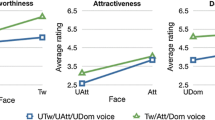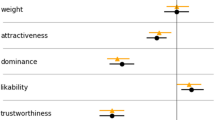Abstract
Two studies examined the effects of attractiveness of voice and physical appearance on impressions of personality. Subject-senders were videotaped as they read a standard-content text (Study 1) or randomly selected texts (Study 2). Judges rated the senders' vocal attractiveness from the auditory portion of the tape and their physical attractiveness from the visual portion of the tape. Other judges rated the senders' personality on the basis of their voice, face, or face plus voice. Senders with more attractive voices were rated more favorably in both the voice and face plus voice conditions; senders with more attractive faces were rated more favorably in both the face and face plus voice conditions. The effects of both vocal and physical attractiveness were more pronounced in the single channels (voice condition and face condition, respectively) than in the multiple channel (face plus voice condition). Possible antecedents and consequences of the vocal attractiveness stereotype are discussed. p]Her voice was ever soft, gentle, and low, an excellent thing in woman.
Shakespeare (King Lear, Act V, Sc. 3)
Similar content being viewed by others
References
Adams, G.R. (1977). Physical attractiveness research: Toward a developmental social psychology of beauty.Human Development, 20, 217–239.
Addington, D.W. (1968). The relationship of selected vocal characteristics to personality perception.Speech Monographs, 35, 492–503.
Allport, G.W., & Cantril, H. (1934). Judging personality from voice.Journal of Social Psychology, 5, 37–54.
Aronovitch, C.D. (1976). The voice of personality: Stereotyped judgments and their relation to voice quality and sex of speaker.The Journal of Social Psychology, 99, 207–202.
Bales, R.F. (1970).Personality and interpersonal behavior. New York: Holt, Rinehart & Winston.
Bass, B.M. (1960).Leadership, psychology, and organizational behavior. New York: Harper.
Berscheid, E., & Walster, E. (1974). Physical attractiveness. In L. Berkowitz (Ed.),Advances in experimental social psychology (Vol. 7, pp. 158–215). New York: Academic Press.
DePaulo, B.M., Rosenthal, R., Eisenstat, R.A., Rogers, P.L., & Finkelstein, S. (1978). Decoding discrepant nonverbal cues.Journal of Personality and Social Psychology, 36, 313–323.
Dion, K.K., Berscheid, E., & Walster, E. (1972). What is beautiful is good.Journal of Personality and Social Psychology, 24, 285–290.
Driver, R. (1987).The voice in person perception: An investigation of the vocal attractiveness stereotype. Unpublished doctoral dissertation, University of Rochester, Rochester, NY.
Ekman, P., Friesen, W.V., O'Sullivan, M., & Scherer, K. (1980). Relative importance of face, body, and speech in judgments of personality and affect.Journal of Personality and Social Psychology, 38, 270–277.
Hatfield, E., & Sprecher, S. (1986).Mirror, mirror ... the importance of looks in everyday life. Albany: State University of New York Press.
Kramer, E. (1964). Personality stereotypes in voice: A reconsideration of the data.The Journal of Social Psychology, 62, 247–251.
Krauss, R.M., Apple, W., Morency, N., Wenzel, C., & Winton, W. (1981). Verbal, vocal, and visible factors in judgments of another's affect.Journal of Personality and Social Psychology, 40, 312–319.
Larrance, D.T., & Zuckerman, M. (1981). Facial attractiveness and vocal likability as determinants of nonverbal sending skills.Journal of Personality, 49, 349–362.
McGrath, J.E., & Julian, J.W. (1963). Interaction process and task outcome in experimentally created negotiation groups.Journal of Psychological Studies, 14, 117–138.
Mehrabian, A. (1970). A semantic space for nonverbal behavior.Journal of Consulting and Clinical Psychology, 35, 248–257.
Miller, G.R., & Hewgill, M.A. (1964). The effect of variations in nonfluency on audience ratings of source credibility.Quarterly Journal of Speech, 50, 36–44.
Osgood, C.E. (1966). Dimensionality of the semantic space for communication via facial expressions.Scandinavian Journal of Psychology, 7, 1–30.
Osgood, C.E., Suci, G.J., & Tannenbaum, P.H. (1957).The measurement of meaning. Urbana: University of Illinois Press.
Pearce, W.B., & Conklin, F. (1971). Nonverbal vocalic communication and perceptions of a speaker.Speech Monographs, 38, 235–241.
Rosenthal, R., Hall, J.A., DiMatteo, M.R., Rogers, P.L., & Archer, D. (1979).Sensitivity to nonverbal communication: The PONS test. Baltimore, MD: Johns Hopkins Press.
Rosenthal, R., & Rosnow, R.L. (1984).Essentials of behavioral research: Methods and data analysis. New York: McGraw-Hill.
Rosenthal, R., & Rubin, D.B. (1982). A single, generous purpose display of magnitude of experimental effect.Journal of Educational Psychology, 74, 166–169.
Scherer, K.R. (1972). Judging personality from voice: A cross-cultural approach to an old issue in inter-personal perception.Journal of Personality, 40, 191–210.
Scherer, K.R. (1974a). Acoustic concomitants of emotional dimensions: Judging affect from synthesized tone sequences. In S. Weitz (Ed.),Nonverbal communication (pp. 249–253.). New York: Oxford University Press.
Scherer, K.R. (1974b). Voice quality analysis of American and German speakers.Journal of Psycholinguistic Research, 3, 281–297.
Scherer, K.R. (1979). Voice and speech correlates of perceived social influence. In H. Giles & R.N. St. Clair (Eds.),Language and social psychology (pp. 88–120). London: Arnold.
Scherer, K.R. (1986). Vocal affect expression: A review and a model for future research.Psychological Bulletin, 99, 143–165.
Scherer, K.R., & Oshinsky, J. (1977). Cue utilization in emotion attribution from auditory stimuli.Motivation and Emotion, 1, 331–346.
Sereno, K.K., & Hawkins, G.J. (1967). The effects of variations in speakers' nonfluency upon audience ratings of attitude toward the speech topic and speaker's credibility.Speech Monographs, 34, 58–64.
Smith, B.L., Brown, B.L., Strong, W.J., & Rencher, A.C. (1975). Effects of speech rate on personality perception.Language and Speech, 18, 145–152.
Snyder, M., Tanke, E., & Berscheid, E. (1977). Social perception and interpersonal behavior: On the self-fulfilling nature of social stereotypes.Journal of Personality and Social Psychology, 35, 656–666.
Sorell, G.T., & Nowak, C.A. (1981). The role of physical attractiveness as a contributor of individual development. In R.M. Lerner & N.A. Busch-Rossnagel (Eds.),Individuals as producers of their development: A life-span perspective (pp. 389–446). New York: Academic Press.
Stein, R.T. (1975). Identifying emergent leaders from verbal and nonverbal communications.Journal of Personality and Social Psychology, 32, 125–135.
Stein, R.T., Geis, F.L., & Damarin, F. (1973). Perception of emergent leadership hierarchies in task groups.Journal of Personality and Social Psychology, 28, 77–87.
Zuckerman, M., Amidon, M.D., Biship, S.E., & Pomerantz, S.D. (1982). Face and tone of voice in the communication of deception.Journal of Personality and Social Psychology, 43, 347–357.
Zuckerman, M., DeFrank, R.S., Hall, J.A., Larrance, D.T., & Rosenthal, R. (1979). Facial and vocal cues of deception and honesty.Journal of Experimental Social Psychology, 15, 378–396.
Zuckerman, M., Larrance, D.T., Hall, J.A., DeFrank, R.S., & Rosenthal, R. (1979). Posed and spontaneous communication of emotion via facial and vocal cues.Journal of Personality, 47, 712–733.
Author information
Authors and Affiliations
Additional information
This research was supported in part by National Institute Mental Health Grant RO1 MH40498-01A2. The authors would like to thank Thomas J. Hernandez, James R. Laguzza, Andrea Lurier, and Mary Elizabeth Sementilli for running the videotaping sessions in Study 1, and Craig B. Partyka, Kimberly A. Radoane, and Kelly B. Sanborn for running the videotaping sessions in Study 2. Grateful acknowledgment is extended to Kate Johnson and Michael Zygmuntowicz for running rating sessions in Study 2, to BiancaMaria Penati for running rating sessions and coding data in Study 2, and to Bradley C. Olson for his assistance with data analysis.
Rights and permissions
About this article
Cite this article
Zuckerman, M., Driver, R.E. What sounds beautiful is good: The vocal attractiveness stereotype. J Nonverbal Behav 13, 67–82 (1989). https://doi.org/10.1007/BF00990791
Issue Date:
DOI: https://doi.org/10.1007/BF00990791




